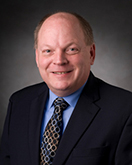
David B. Spencer, Ph.D.
Professor of Aerospace Engineering
229A Hammond Building
Penn State University
University Park, PA 16802
Phone: 814-865-4537 / Fax: 814-865-7092
E-mail: dbs9@psu.edu
David Spencer is writing a how-to guide for getting from Earth to Jupiter – only because the distance is long and the conditions tricky, the guide comes in the form of an entire textbook, “Interplanetary Astrodynamics.” In fact, Spencer’s textbook will be useful for getting from any one planet to any other, a reference not only for graduate students and professors but also for, in Spencer’s words, “every mission planner and navigator at NASA’s Jet Propulsion Laboratory, so they can turn to it and get up to speed.”
Broadly speaking, Spencer is interested in how a space vehicle or other object operates when it is subject to the gravitational forces of more than one heavenly body -- the Earth and the Moon, for example. A breakthrough in people’s understanding of how to simulate trajectories for vehicles flying under the influence of multiple planets was the introduction of dynamical systems theory, the recognition that the motion occurs in six dimensions, not the traditional three – with the extra dimensions necessary to account for the complex relationship between a vehicle’s position and its velocity.
Spencer’s interest in space travel developed when he was a teen-ager following the progress of the two Voyager probes in the 1970s. At the time, a TV commentator said that accurately launching a spacecraft from Earth to Jupiter was like pitching a baseball from Dodger to Yankee stadium and landing a strike. Spencer found that idea fascinating, and today – as a professor of aerospace engineering at Penn State -- he still does. In fact, the overarching goal of Spencer’s current research is to improve the likelihood of NASA “throwing strikes,” in other words to improve the trajectory accuracy of a vehicle traveling in space. Better trajectory accuracy means missions last longer, are cheaper and more fuel-efficient to operate, and can carry more scientific instruments because they don’t have to carry excess fuel.
According to Spencer, it’s not possible to view trajectory accuracy – or any other problem relating to space travel– in isolation. The interrelatedness of the problems and the means of solving them are so complex that each must be seen as part of the larger system. For example, space missions are not typically cut short because a vehicle runs out of “gas,” but because hardware like a battery or an electronic component fails. In his undergraduate course on spacecraft design, Spencer teaches a systems-wide approach, considering all the technologies involved, including life support when people are on board, power, propulsion, thermal protection, dynamics and controls.
If a systems approach can be extended to the academy, Spencer’s career offers a good example of what he calls “the way it is supposed to work” – a set of reinforcing feedback mechanisms that in the end expand knowledge. As a graduate student at Purdue University and later at the University of Colorado, Spencer was mentored in the creation of his theses on astrodynamics. He still is in frequent touch with his own mentors, even as he learns from the work of his own Ph.D. students. Likewise, teaching responsibilities such as preparing lectures dovetail with the work he is doing on his book.
David Spencer grew up in Lexington, Kentucky, where his parents worked at IBM. Memorable in his childhood was the July night in 1969 when his parents woke him up, sat him down in front of the television, and said, “Watch this.” He admits it wasn’t till later that he fully understood the significance of the fuzzy black and white image of Neil Armstrong walking on the lunar surface, but even then his interest was piqued.
While neither of Spencer’s parents attended college, their work with engineers gave them an appreciation of the benefit of a college education, and they always assumed their own three children would go. Today, Spencer and his two sisters have a total of eight degrees. Spencer earned his bachelor’s degree at the University of Kentucky, his master’s at Purdue, and in 1994 his Ph.D. in aerospace engineering sciences at the University of Colorado. He also earned an MBA from Penn State's on-line iMBA program.
Among his industry experience is a stint at The Aerospace Corporation in Los Angeles during the early 1980s where he believes his work on air-launched anti-satellite missiles directly contributed to ending the Cold War. “We were able to shoot down an orbiting satellite with a missile launched from an F-15 jet, something the Soviets knew they were nowhere near being able to counter,” Spencer said. “When Reagan heard about that success, he was thrilled. He immediately recognized the political implications.”
In 1999, Spencer was leading a research team at the Air Force Research Laboratory in Albuquerque when he was invited to apply for an opening at Penn State. At the same time he was also applying for a position in Washington, D.C. On the outskirts of Washington where he was going to interview, he and his family got stuck in traffic, and his wife said, “I think I like State College.”
Today, Spencer is a professor of aerospace engineering at Penn State.
